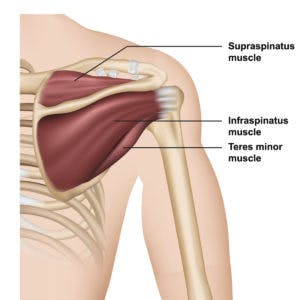The rotator cuff is a group of 4 muscles spanning from your shoulder blade to your upper arm (humerus bone). These muscles are the supraspinatus, infraspinatus, teres minor, and subscapularis. The primary role of the rotator cuff is to center the ball (end of the humerus) in the socket (shoulder blade). A poorly functioning rotator cuff will result in pain, weakness, altered movement, and disability. This is common in people with rotator cuff tears. Thankfully, there are exercises that can help.

The tendons of your rotator cuff can become injured or torn by trauma such as a fall. However, many tears do not involve any trauma. The incidence of tears increases with age. The prevalence of tears is between 20% and 30% in people 60 to 80 years old. However, many individuals with tears of all sizes do not have any pain.
Surgery and Rotator Cuff Tears
The torn tendons may not fully heal themselves. Surgery repairs the torn tendons. However, many tendon repeairs re-tear. Although as high as 20% to 30% of rotator cuff repairs may re-tear, functional outcomes are typically very good following surgery. However, surgery may not be a viable option for all individuals. Many people with rotator cuff tears seek non-operative solutions. Exercise is a proven non-surgical treatment option for many people with small and large tears.
Research Supporting Exercise for Rotator Cuff Tears
A recent study out of Denmark showed 5 months of exercise improved function by nearly 50% in people with large rotator cuff tears. Strength, range of motion, pain, and quality of life also improvemed in people judged not to be surgical candidates. Another study from Vanderbilt University showed 75% of patients with full-thickness tears respond well to exercise. After two years, only 25% of patients in this study chose to pursue surgery. These studies support the role of exercise as an alternative to surgery for people with tears.
Strengthening Exercise for the Rotator Cuff
So we know exercise can be effective. But what are some of the best exercises to strengthen your shoulder if you have a rotator cuff tear? Recall, the primary role of your rotator cuff is to center the ball in the socket to allow your arm to function. A secondary role is to produce rotational movements of your upper arm. These rotational movements are necessary for everyday living. They occur when you reach overhead or behind your back. Therefore, exercises that activate the rotator cuff and involve coordination with other muscles are best.
Sidelying external rotation is one important exercise that preferentially activates the rotator cuff. In particular, this exercise targets the infraspinatus and teres minor. Also, it is best for you to begin this exercise with very light weights. Another lower-level exercise that can be incorporated is the standing row or any of its variations. The row activates all rotator cuff muscles at a low level along with strengthening the muscles of your shoulder blade. Rows are performed with a cable, resistance band, or light dumbbells.
Advanced Exercises
Advanced exercises are incorporated after the basics are mastered. However, not everyone will progress to these more challenging exercises. Arm raises lying on your stomach activates your supraspinatus and infraspinatus. The most commonly torn tendon of the rotator cuff is the supraspinatus. Also, diagonal movements train the coordination of all rotator cuff muscles along with the muscles of the upper arm and shoulder blade.
Closing Thoughts on Rotator Cuff Exercise
There are no one-size-fits-all exercise programs suitable for everyone with rotator cuff tears. An individualized exercise program should be developed by your physical therapist. The exercise program should be based on a detailed interview and physical examination. Exercises should then target your specific areas of weakness and your goals. Contact us if you have questions about how to get started.


